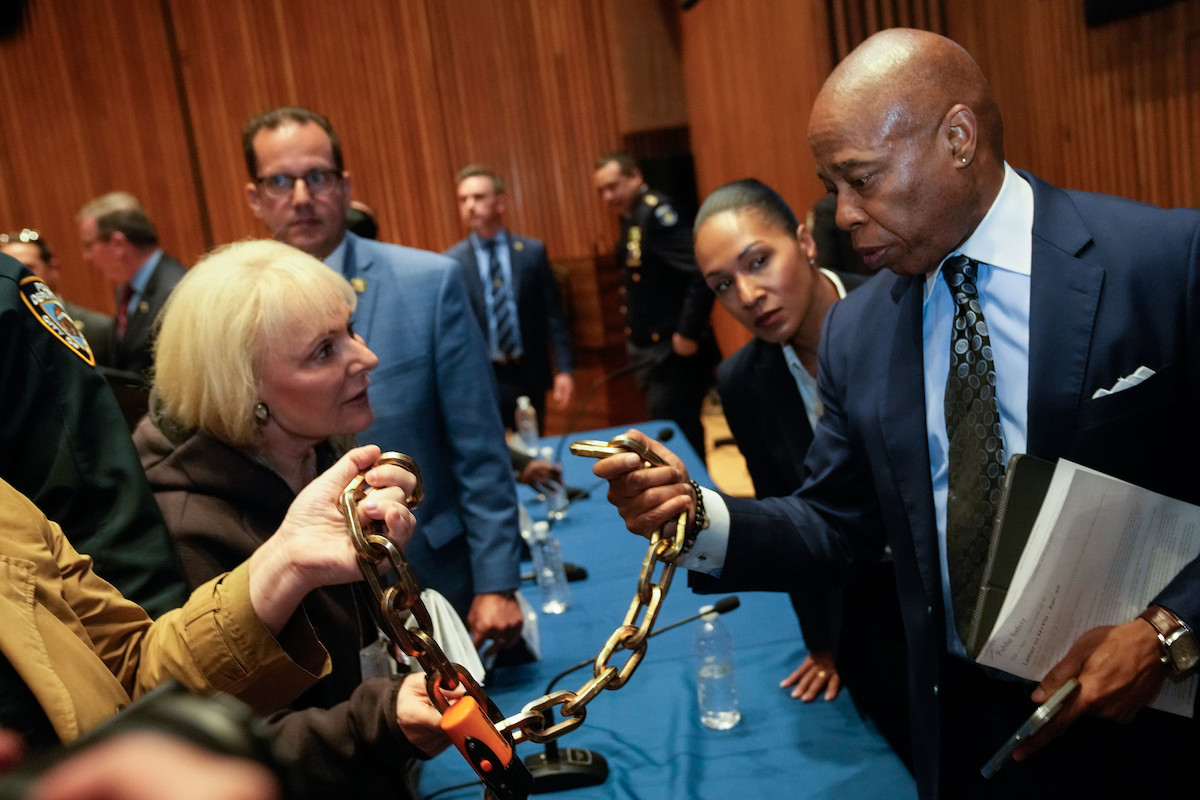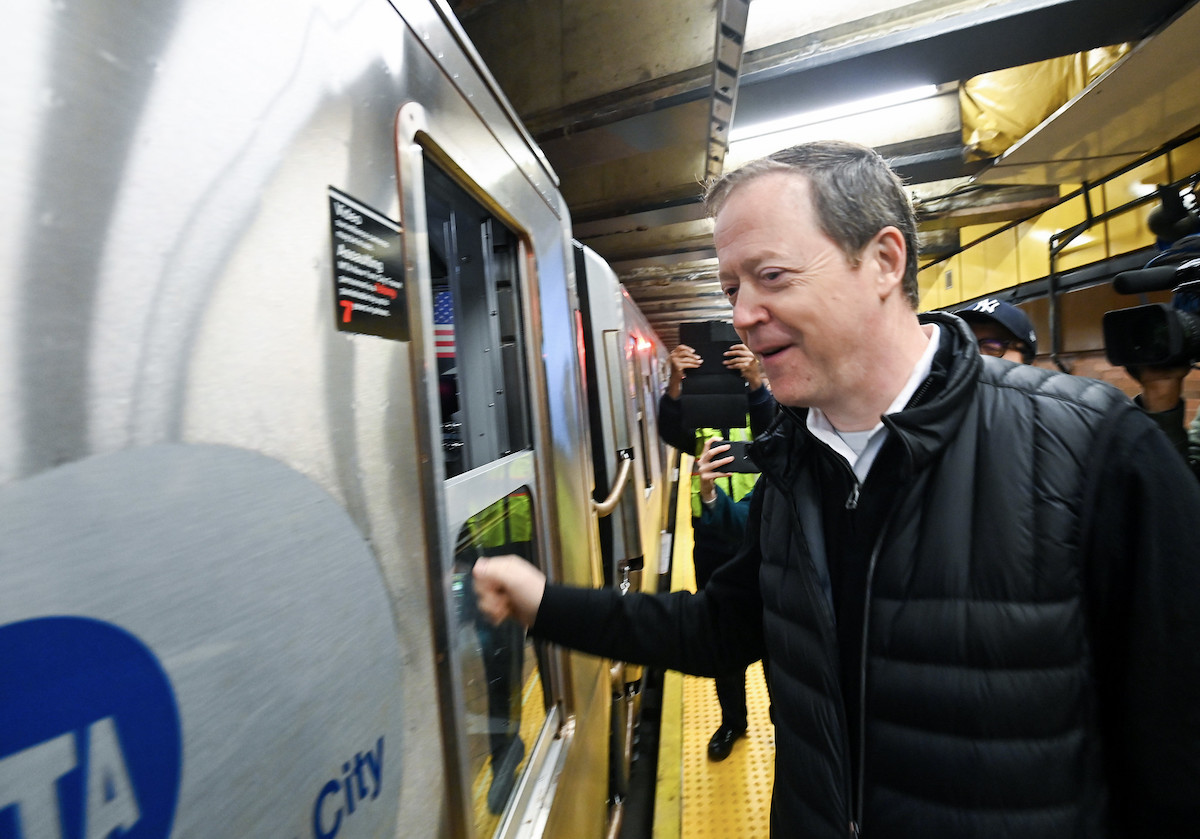Wielding little more than a common bike lock as evidence, Mayor Eric Adams declared that the violent arrests of hundreds of people at Columbia University and CUNY's City College of New York on Tuesday night were necessary because of "outside agitators," and a global conspiracy to "radicalize young people."
"There is a movement to radicalize young people. And I'm not going to wait until it's done and all of a sudden acknowledge the existence of it," Adams told reporters. "This is a global problem. Young people are being influenced by those who are professionals at radicalizing our children, and I'm not going to allow that to happen."
NYPD officials stated that 282 people were arrested at both schools, 173 at CCNY and 109 at Columbia, with little to no injuries, but repeatedly declined to state how many of those arrested were "outside agitators," or provide the criteria of how the police department determines who is branded with this label.
And here is @NYPDDCPI doing what I did not hear during the press conference, which is confirming that "outside agitators" were in fact arrested inside @Columbia's Hamilton Hall. No word on how many, or who, or what criteria for "outside agitator" is. pic.twitter.com/H9y1xdpVGm
— Christopher Robbins (@ChristRobbins) May 1, 2024
At one point during the 30-minute press conference, Adams acknowledged that the term "outside agitators" was used extensively by racist police officials in the Jim Crow South during the civil rights movement of the 1960s, but insisted that he was using it differently.
"We understand that. But this police department cannot get caught up on what's the politically correct terminology. We have to be caught up on public safety," Adams said. "There were individuals on the campus who should not have been there. They were people who are professionals. And we saw evidence of training. We saw a shift in tactics that were being used. And when you start using the intelligence that Intel was able to supply, we knew it was time to communicate directly with the school and say you have more than a peaceful protest on your hands."
Among the "evidence" police officials presented to make this case: a map of where protests were planned, a stick that was partially wrapped in tape (according to the NYPD's Deputy Commissioner for Intelligence and Counterterrorism, Rebecca Weiner, this was "a very rudimentary makeshift weapon") and a bike lock that police said the protesters used to barricade themselves into Hamilton Hall.

The only time the bike lock was referenced during the press conference was when NYPD Commissioner Edward Caban theatrically lifted it up and tossed it down on the table.
"They tried to lock us out," Caban said, raising the lock for the cameras. "But the NYPD and the people of the city of New York will never be locked out, and we will always work together to keep our city safe."
But the bike lock has a much more significant role to play in the NYPD's theory of what is going on right now on American college campuses: Earlier on Wednesday morning, head NYPD spokesperson, Deputy Commissioner for Public Information Tarik Sheppard, went on MSNBC with the lock. "This is not what students bring to school, OK?" Sheppard said. In fact, as many people have noted, Columbia University itself promoted the bike lock to its students as a way of deterring bike thefts.
When this was pointed out to Sheppard after the press conference, he insisted that the lock was somehow indicative of nefarious, outside influences. "Look at this," Sheppard said gravely, holding the chain with two hands, like a jeweler selling a necklace. "This is an industrial chain."
Here is @katie_honan confronting @NYPDDCPI with evidence that the chain he wielded to imply that “outside agitators” barricaded Hamilton Hall is a common bike lock that @Columbia itself sold to their students pic.twitter.com/j7lU9Nm1GO
— Christopher Robbins (@ChristRobbins) May 1, 2024
The NYPD and the mayor's central claim is that these nefarious influences were poisoning the minds of otherwise innocent students. "Those who broke into the building did include students, [but] it was led by individuals who are not affiliated with the university," Adams said.
If they have actual evidence that these people committed serious crimes, why not release it? What about the "wife of a terrorist" that the Post reported was on Columbia's campus?
Weiner admitted that the woman in question wasn't there on Tuesday night. "And we have no evidence of any criminal wrongdoing on her part," Weiner said. "But that's not somebody who I would want necessarily influencing my child if I were a parent of somebody at Columbia, or the individuals who are involved in doing some of this training and tactical awareness activity."
Instead, the Adams administration—and Columbia University—argued that spreading certain kinds of information is justification for a military-style raid using thousands of armed police officers. "This is not about students expressing ideas. It is about a change in tactics that presents a concern and a normalization and mainstreaming of rhetoric," Weiner said, referring to things that are not in and of themselves, crimes. "And I'm not just talking about language. I'm now talking about tactics."
Weiner added, "These students don't come in the doors knowing how to barricade themselves behind barriers that they've created. These are all skills that are taught and learned."

It might have been easier to understand what was going on if the NYPD hadn't prevented journalists from witnessing the storming of Hamilton Hall, and blocked reporters from CCNY's campus while they arrested protesters.
Sheppard, the NYPD spokesperson, insisted "we are very transparent."
"It was just an amazing job," Sheppard said. "Make no mistake about it, this is a very difficult operation. But we made it look like it wasn't problematic. And the reason was the skill of the cops that were out there last night. A lot of people would have resisted. But the way that these officers talked to them, handled them, and took them into custody, it was very professional."
Arrests at City College as police attempt to clear sidewalk in front of college gates. pic.twitter.com/0b6yGBTnRd
— Hell Gate *subscribe today!* (@HellGateNY) May 1, 2024
Other questions: How many thousands of police officers participated in the raids? Who is going to pay for their presence on Columbia's campus, especially since the school has asked them to remain through May 17? Why did NYPD officials film themselves tossing away a Palestinian flag and hoisting an American flag on CCNY's campus? (Oh, and the giant tactical vehicle the NYPD used to get into Hamilton Hall? "All that equipment you see is life-saving equipment," NYPD Chief of Department Jeffrey Maddrey stated.)
This reporter did not get called upon for a question, though it wasn't for a lack of trying, and so we resorted to shouting a question at the end.
"You gotta raise your hand," NYPD Chief of Patrol John Chell chided us as he left the dais. "Get in the game, you gotta raise your hand, you can't just shout."





